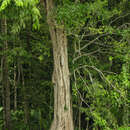en
names in breadcrumbs


This taxon occurs in the Moist Pacific Coast mangroves, an ecoregion along the Pacific coast of Costa Rica with a considerable number of embayments that provide shelter from wind and waves, thus favouring mangrove establishment. Tidal fluctuations also directly influence the mangrove ecosystem health in this zone. The Moist Pacific Coast mangroves ecoregion has a mean tidal amplitude of three and one half metres,
Many of the streams and rivers, which help create this mangrove ecoregion, flow down from the Talamanca Mountain Range. Because of the resulting high mountain sediment loading, coral reefs are sparse along the Pacific coastal zone of Central America, and thus reef zones are chiefly found offshore near islands. In this region, coral reefs are associated with the mangroves at the Isla del Caño Biological Reserve, seventeen kilometres from the mainland coast near the Térraba-Sierpe Mangrove Reserve. The Térraba-Sierpe, found at the mouths of the Térraba and Sierpe Rivers, is considered a wetland of international importance.
Because of high moisture availability, the salinity gradient is more moderate than in the more northern ecoregion such as the Southern dry Pacific Coast ecoregion. Resulting mangrove vegetation is mixed with that of marshland species such as Dragonsblood Tree (Pterocarpus officinalis), Campnosperma panamensis, Guinea Bactris (Bactris guineensis), and is adjacent to Yolillo Palm (Raphia taedigera) swamp forest, which provides shelter for White-tailed Deer (Odocoileus virginianus) and Mantled Howler Monkeys (Alouatta palliata). Mangrove tree and shrub taxa include Red Mangrove (Rhizophora mangle),Mangle Caballero (R. harrisonii) R. racemosa (up to 45 metres in canopy height), Black Mangrove (Avicennia germinans) and Mangle Salado (A. bicolor), a mangrove tree restricted to the Pacific coastline of Mesoamerica.
Two endemic birds listed by IUCN as threatened in conservation status are found in the mangroves of this ecoregion, one being the Mangrove Hummingbird (Amazilia boucardi EN), whose favourite flower is the Tea Mangrove (Pelliciera rhizophorae), the sole mangrove plantpollinated by a vertebrate. Another endemic avain species to the ecoregion is theYellow-billed Cotinga (Carpodectes antoniae EN).Other birds clearly associated with the mangrove habitat include Roseate Spoonbill (Ajaia ajaja), Gray-necked Wood Rail (Aramides cajanea), Rufous-necked Wood Rail (A. axillaris), Mangrove Black-hawk (Buteogallus anthracinus subtilis),Striated Heron (Butorides striata), Muscovy Duck (Cairina moschata), Boat-billed Heron (Cochlearius cochlearius), American White Ibis (Eudocimus albus), Amazon Kingfisher (Chloroceryle amazona), Mangrove Cuckoo (Coccyzus minor), Yellow Warbler (Setophaga petechia), and Black-necked Stilt (Himantopus mexicanus VU) among other avian taxa.
Mammals although not as numerous as birds, include species such as the Lowland Paca (Agouti paca), Mantled Howler Monkey (Alouatta palliata), White-throated Capuchin (Cebus capucinus), Silky Anteater (Cyclopes didactylus), Central American Otter (Lontra longicaudis annectens), White-tailed Deer (Odocoileus virginianus), feeds on leaves within A. bicolor and L. racemosa forests. Two raccoons: Northern Raccoon (Procyon lotor) and Crab-eating Raccoon (P. cancrivorus) can be found, both on the ground and in the canopy consuming crabs and mollusks. The Mexican Collared Anteater (Tamandua mexicana) is also found in the Moist Pacific Coast mangroves.
There are a number of amphibians in the ecoregion, including the anuran taxa: Almirante Robber Frog (Craugastor talamancae); Chiriqui Glass Frog (Cochranella pulverata); Forrer's Grass Frog (Lithobates forreri), who is found along the Pacific versant, and is at the southern limit of its range in this ecoregion. Example salamanders found in the ecoregion are the Colombian Worm Salamander (Oedipina parvipes) and the Gamboa Worm Salamander (Oedipina complex), a lowland organism that is found in the northern end of its range in the ecoregion. Reptiles including the Common Basilisk Lizard (Basiliscus basiliscus), Boa Constrictor (Boa constrictor), American Crocodile (Crocodilus acutus), Spectacled Caiman (Caiman crocodilus), Black Spiny-tailed Iguana (Ctenosaura similis) and Common Green Iguana (Iguana iguana) thrive in this mangrove ecoregion.
Pterocarpus officinalis, the dragonsblood tree, is a species of flowering plant in the family Fabaceae, native to southern Mexico, Central America, the Caribbean, and northern South America.[2][3] It is typically found in coastal freshwater or slightly brackish habitats, in association with mangroves that occupy the more saline areas.[4] Its timber is commercially traded.[5]
Pterocarpus officinalis, the dragonsblood tree, is a species of flowering plant in the family Fabaceae, native to southern Mexico, Central America, the Caribbean, and northern South America. It is typically found in coastal freshwater or slightly brackish habitats, in association with mangroves that occupy the more saline areas. Its timber is commercially traded.